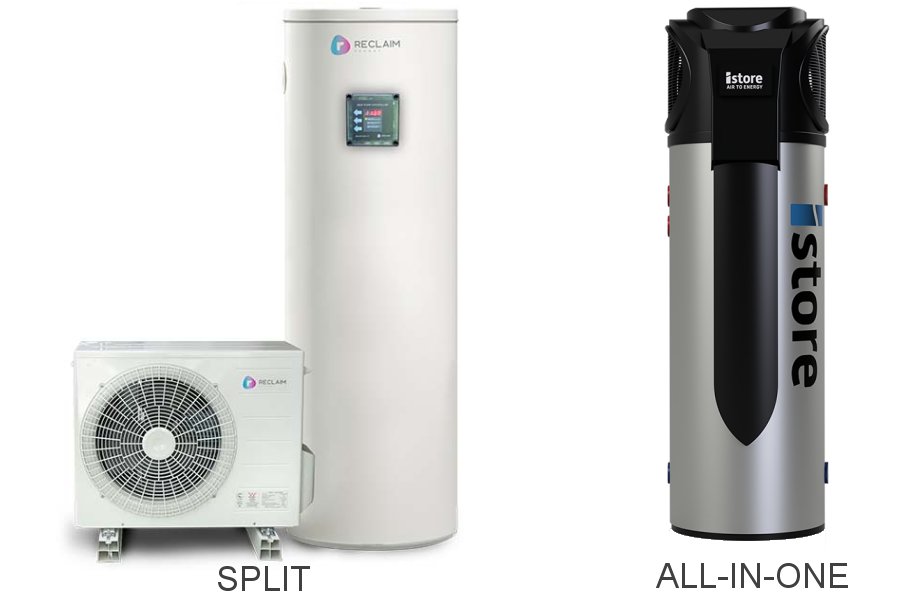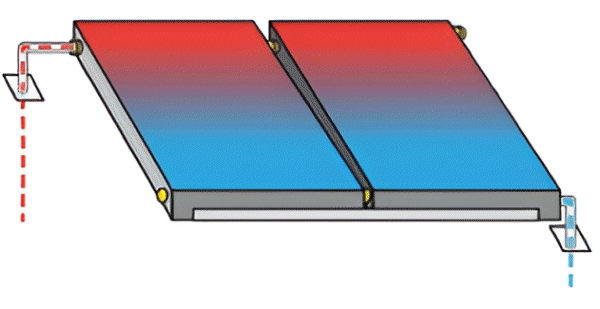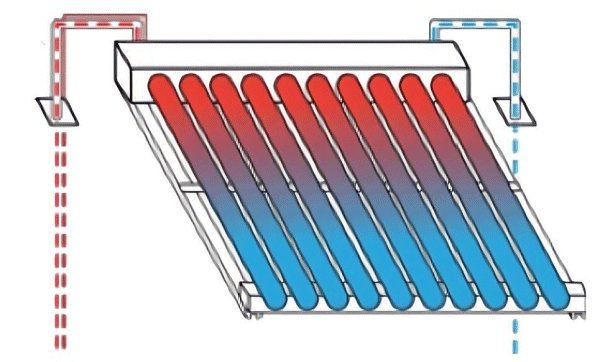Slash Your Water Heating Bills With Solar Hot Water
Last Updated: 19th Dec 2025 By Finn Peacock, Chartered Electrical Engineer
Water heating is the second biggest energy user in a typical Aussie home after space heating and cooling. So, if you want an efficient home, you need to look at this activity.
Unfortunately, in our sun-drenched country most homes still heat 100% of their water with an inefficient resistive electric element (AKA a giant kettle) with electricity from the mains grid; or a gas flame. In Australia, this doesn’t make a lot of sense – unless you have an electric hot water system and solar panels – and have them working together.
A good solar hot water system combined with solar PV can reduce your water heating bills by 90%.
A Hot Water System Can Act As A Cheap Battery
When it comes to solar energy, hot water is almost the perfect electrical load. It can accept solar energy at any time, storing it as heat. A good, well-insulated hot water system can be like a big solar battery. It stores your energy, ready for when you need it. You can heat the water during the day and use it the following morning. And a hot water system is much cheaper than a home battery.
Options For Using Solar For Water Heating
There are many options for choosing a solar hot water system and even more opinions out there on what you should buy. The net result is that buying solar hot water can be confusing as each vendor passionately tells you how their solution is the best. It is not unusual for the confused consumer to give up and do nothing, sticking with their horribly inefficient electric or gas storage system.
To avoid this tragic result, I will try and dispassionately work through what kind of solar hot water system is best for you before you go and get quotes. I spent a lot of time thinking about the best way to approach buying solar hot water, and I think I’ve managed to distil it into three high-level questions/decisions.
Question #1: What type of hot water system?
Answer: Get A Heat Pump – if possible.
If finances and roof space allow, the best solution to heating water in a home in Australia, particularly a solar home, is a hot water heat pump system.
Heat Pump Solar Hot Water
A heat pump is a solar hot water system that takes the heat out of the air and transfers it into the water. You can read the details of how heat pumps work here.
Heat pumps can look like an air conditioner piped to a hot water cylinder. Some consider them pretty ugly, but you can also get sleek all-in-one units with the heat pump integrated into the top of the cylinder:
If you live outside QLD or the tropics, then give or take $100 per year in electricity costs, modern heat pumps are about as efficient as a flat plate solar hot water system. A conventional SHW system will be much more efficient in QLD and the tropics than a heat pump. So bear that in mind.
A good heat pump is as quiet as a good quality air conditioner and will work well even in freezing temperatures, albeit with a reduced efficiency. They are electrically powered, and if you have PV, then averaged over a year, they’ll generally soak up the output from 1.5kW of panels. If you get a heat pump and have PV, I recommend simply putting it on a timer to operate between 10am and 3pm to power it with solar most days.
In my experience, heat pumps are more suited to you if some or all of these are true:
- You have space outside your home for a storage cylinder and heat pump unit.
- Your hot water cylinder will go where the slight compressor hum won’t annoy anyone.
- You sensibly want to keep your roof space for solar PV panels.
- You’d rather pay $3,000 – $4,000 for a fully installed heat pump system than $4,000 – $8,000 for conventional solar thermal hot water.
If some or all of the bullets above describe your situation, go for a heat pump. Good heat pump brands include Reclaim and iStore.
If you have decided that a heat pump is right for you, then make it your mission to get one installed as soon as possible – it will save you money immediately. If you power it with solar electricity, you should be able to reduce your hot water heating costs by 80-90%. That’s $700-$1000 per year for a family home.
Heat pumps are cheaper and simpler to install than conventional solar hot water. Still, the unit is more complex mechanically, with refrigerant, pumps and fans. It will also emit a low hum when running.
If you’ve plumped for a heat pump, you can stop reading now – the rest of this section is for those of you who have decided to pay a bit more for conventional solar hot water.
Conventional Solar Hot Water (SHW)
A conventional SHW system pushes your water through ‘solar hot water panels’ called ‘collectors’ on your roof to heat your water. These panels absorb the heat from the sun to heat your water. Simple as that. When there is not enough sun, you use an electric or gas boost to top up the heat.
Depending on your climate zone and collector design, these systems will use the sun to provide 50-95% of your water heating energy. A consistently hot climate throughout the year is at the upper end of that scale, and anywhere in Australia where you can ski in winter will be at the lower end.
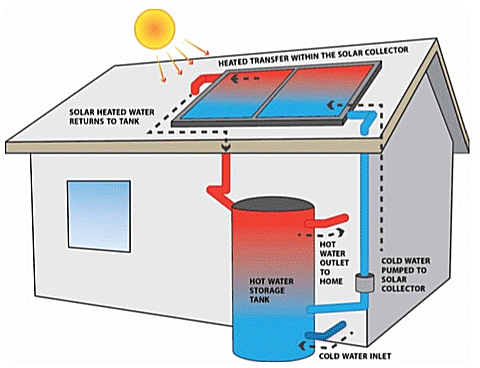
A conventional solar hot water system: Your water is heated on the roof. The tank can be on the ground (as shown) or on the roof. Source: Dept of Resources, Energy and Tourism
A well-designed solar thermal hot water system is elegant, reliable and efficient. On your roof, it sits out of sight, silently working away day after day, using the sun’s heat to supply most of your family’s hot water needs directly. A good system should last 20 years and have a maintenance checkup every five years. Fully installed, it will cost between $4,000 and $8,000, depending on the size and collector type.
If you have a solar PV system too (and you should), then your solar electricity can provide most of the boosting energy. Overall, with PV-boosted solar hot water, you are looking at 80-90% of your water heating coming from the sun. Now, that’s what I call an efficient system.
However, I must stress that they require roof space, the installation of pipes up to your roof, and a relatively significant up-front investment.
Question #2: Should you get a flat plate or evacuated tube collector?
Answer: Flat plates are the way to go unless you live in a cold climate zone.
There are two types of solar hot water collectors to choose from if you go the conventional SHW route: the flat plate and the evacuated tube. And believe me, they each have their die-hard fans.
Flat Plate
Flat plate collectors are simpler, cheaper, and more durable but less efficient in colder climate zones than evacuated tubes.
Flat plates are also easier to install in a ‘thermosiphon’ configuration, my favourite design for solar hot water. Thermosiphon means ‘tank on the roof’. The beauty of this is that there are no moving parts or pumps. When your tank is on your roof, the water circulates naturally due to hot water rising. This is called the thermosiphon effect. It works well and is reliable and silent. It also means that your water tank is out of the way, freeing up valuable space on the ground. A thermosiphon system will work away quietly for decades.
Evacuated Tubes
Evacuated tube collectors are more expensive and delicate but more efficient in cooler climates.
A disadvantage of evacuated tubes is that they almost always come as a ‘split system’. That means your tubes are on the roof, but your tank is on the ground. Water is circulated with a pump. A good circulating pump will only draw a tiny 20W. That’s about a dollar a week in electricity, so it’s not a huge deal. A pump that small is also very quiet. But pumps do degrade, and you will need to replace your pump every 5-7 years. So bear that in mind.
The pump also needs a controller, including temperature sensors, which adds to the system’s complexity. More complexity means more failure modes and less reliability. A common complaint with a split system is that the pump starts running at inappropriate times due to failed or badly installed temperature sensors.
Flat Plate vs. Evacuated Tube
You need at least two pieces of information to decide which collector is right for you:
- How much will each option cost?
- The savings each collector can provide in your climate.
Then you can decide if the extra energy from the evacuated tubes is worth the additional cost.
Cost of Flat Plate vs. Evacuated Tube
A flat plate solar hot water system for a 4-5 person home, with a 350-litre tank, will cost $4,000-$5,000 fully installed. A similar-sized evac tube system will cost $7,000 – $9,000.
Climate Zone Compatibility
So, with that in mind, here’s a map showing how much of your annual hot water heating a regular flat plate system can provide in your part of Australia:
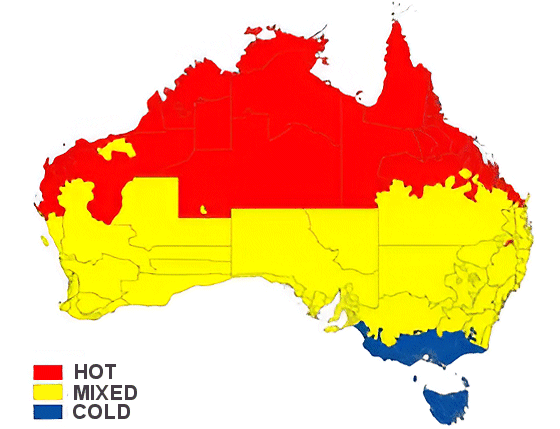
Image credit: energyRating.gov.au
Red – Hot climate zone: Flat plate is for you. Expect 80-95% savings with a flat plate SHW. A flat plate system with an electric boost is all you need in this climate. Get a well-installed flat plate solar hot water system, and you’ll be paying bugger all to heat your water for the next 20 years.
Yellow – mixed zone: Expect your flat plate SHW system to give 60-80% savings, with the further north you are, the better: Brisbane 80%, Sydney 70%, Adelaide and Perth closer to 60%.
Do you need evacuated tubes in the yellow zone?
If you choose good quality evac tubes, you could add about 15% to these numbers and 20% in Adelaide and Perth, giving savings of Brisbane: 95%, Sydney 85% and Adelaide/Perth 80%. So evacuated tubes will provide you with a kick-ass efficient system, but you’ll be paying $3,000-$4,000 more to save an extra $200ish per year (and you’ll save even less if you are boosting with PV). So, only get evacuated tubes if efficiency is more critical than payback.
Blue–cold zone: Expect savings of less than 60%, perhaps as low as 35% in Tassie and The Snowies. Evacuate tube collectors here can double the savings compared to a flat plate, so it is worth considering. Evacuated tubes can provide excellent heating on a winter’s day.
Question #3: Should you boost with electricity or gas?
Hurrah – we’re down to the last decision. Do you boost the solar hot water with gas or electricity?
Boosting with gas
If you already have an instant gas water heater, then reusing it as your booster makes sense. When you get quotes, get the installer to check that the specs of your existing unit make it suitable as a booster. If it is reasonable, reuse it and save yourself at least $1,000.
If you need a new instant unit, consider an electric boost instead. It is an excellent opportunity to move away from gas altogether.
Note on the efficiency of instant gas vs. electric boost: An instant gas boost is more efficient at heating water than an electric boost in transferring the energy from the fuel to the water. If you only consider the cost of the gas (and not the standing charges on your gas bill), then it is also cheaper to boost your solar water heater with gas.
Why move away from gas?
So why am I recommending replacing your cheap, efficient instant gas boost with a resistive electric boost? Moving away from gas will give you lower bills in the medium term.
Gas is getting less and less useful as a fuel for Australian homes. For example, households are moving to solar electricity and reverse-cycle air conditioners for space heating.
Water heating is best done with solar hot water (or a heat pump). And if you have an adequate solar hot water system, you’ll use so little gas that the most significant part of your bill will be the gas company’s daily service charge.
And yes, cooking on gas is fantastic. But so is electric induction cooking. Seriously – try it out before you dismiss it.
So consider ditching gas altogether, starting with your hot water – and maybe moving to induction cooking later. You can then arrange to have the gas meter removed and avoid the daily service charge.
I should also mention that the methane released in gas production is one of the nastiest greenhouse gases out there – and gas use encourages the scourge that is fracking. So, getting off gas is the right thing to do environmentally.
Boosting with electricity
The simplest electric boosters heat your water with a resistive element. They are cheap and reliable. Although resistive elements are not efficient as a standalone solution, they make the most economic sense as a booster to solar hot water, combined with solar electricity.
The Wild-Card Solution: Direct PV
While the cost of solar PV panels has dropped 80% since 2009, the price of solar hot water systems has not. The result is that it is cheaper to buy enough extra solar PV panels to power your existing electric hot water cylinder than it is to buy a solar hot water system.
So why doesn’t everyone do this? A reason can be roof space.
As batteries and electric cars become affordable, roof space will become more valuable. When roof space is at a premium, the smaller the area required for water heating, the better. But the good news is that panels have become more efficient over the years, meaning less rooftop space is needed to generate the same amount of power.
Conclusion
With water heating using 25-30% of your home’s energy consumption, you cannot have an efficient home if you don’t have an efficient hot water system. Whether you get a heat pump, conventional solar hot water or go the direct PV route, consider investing in a ‘PV diverter‘ so that any excess energy from your solar electricity system can boost your hot water. You can view a comparison of solar hot water diverters here.
By the way, I have an entire section dedicated to solar hot water here if you wish to take a deeper dive into this topic.
In the next article, we’ll look at gauging the energy efficiency of home appliances, including translating energy star rating labels.
